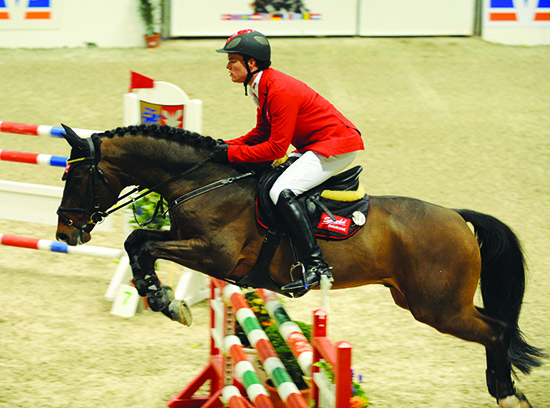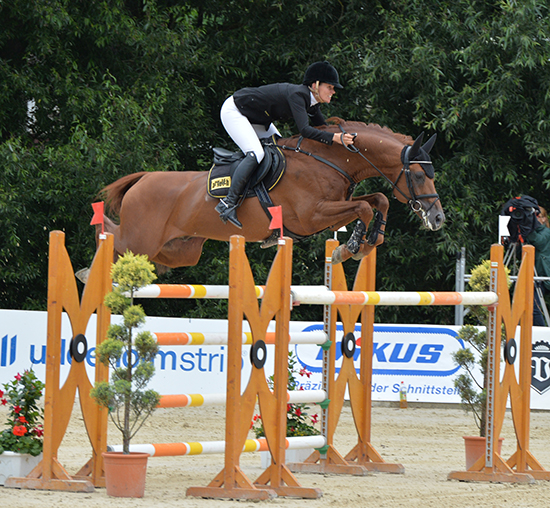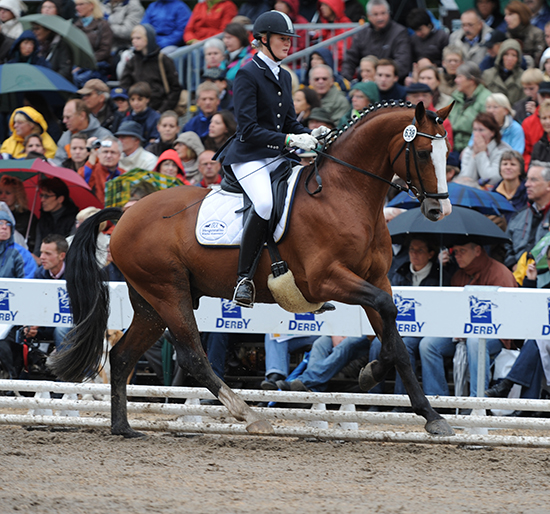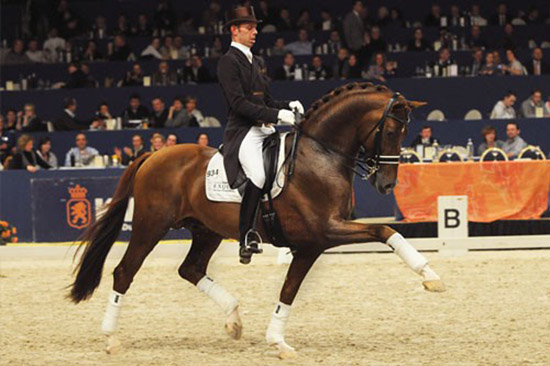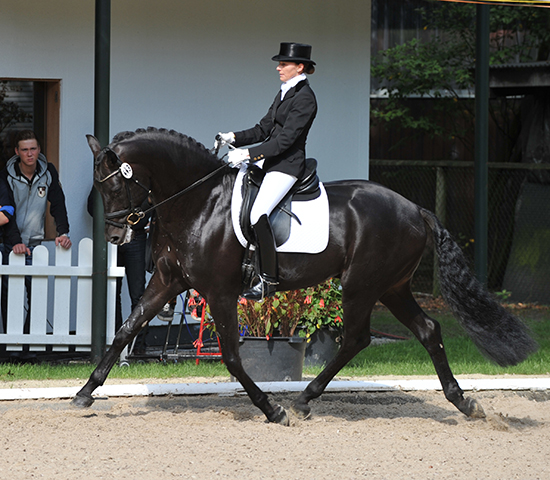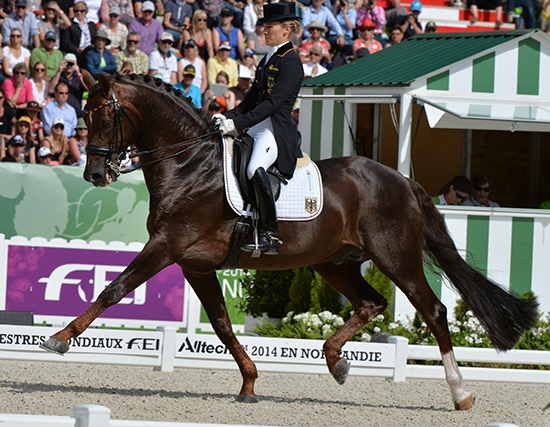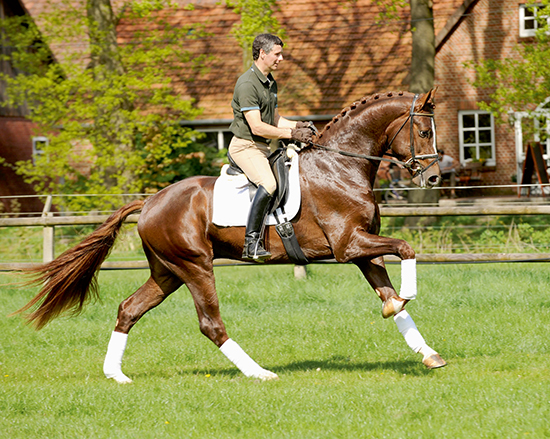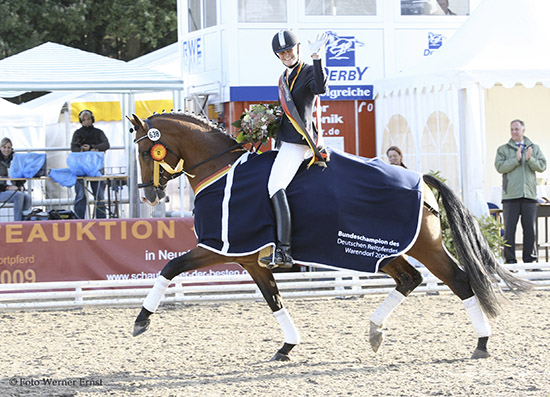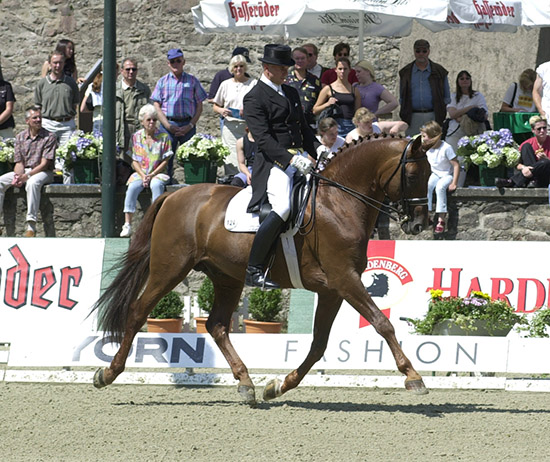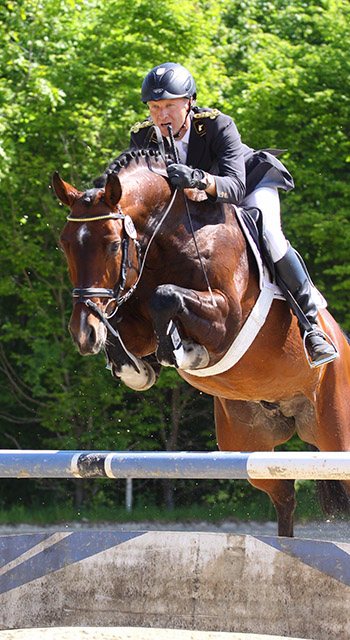Analysis by Christopher Hector
I suppose the best thing you can say about the German FN breeding values is that no-one, save the bureaucrats who prepare them, the owners of the stallions who rank highly, and the odd grumpy equestrian journalist, takes any notice of them but dear me, this year’s rankings must count amongst the whackiest!
Stakkato Gold at his moment of glory – first in the 7/8 year old class at Neumünster
The Number One Jumping Breeding Stallion in Germany is… wait for it, Stakkato Gold (breeding value 172). Now I was one of the privileged few who actually saw the highlight of Stakkato Gold’s jumping career when he WON the 7/8 year old Young horse class at Neumünster in 2009, his last season of competition before he was injured. All told, Stakkato Gold won €7,983.
Nor has he been any super sire since his retirement from the competition ring. Balouska won the Grand Prix of Oman***, Seal won the Grand Prix of Verden, and was second in the Grand Prix of Offenburg, both two star CSIs, Silence was second in a World Cup qualifier in Wellington, and third in the World Cup at Thermal, Stakorado won two Grand Prix in Leszno and Siauliai. That’s it, then there’s a respectable number of young horses working their way through the ranks. Not surprisingly, Stakkato Gold does not even make the WBFSH top fifty jumping stallions list, which is solely based on international performance results.
Compare Stakkato Gold’s career with the equal third placegetters on the German FN topliste, Cornet Obolensky and Stakkato Gold’s dad, Stakkato, with a breeding value of 166. Cornet Obolensky was an international jumping star, and won €777,876 AND has so far sired 33 horses competing at a 1.60m level, including superstars like Cornet d’Amour (winnings €836,864) , Coronado NRW (€616,157) and Cornet’s Cristallo (€349,822), and there are early signs that he might be a good sire of sires…
Stakkato was always an honest competitor with lifetime earnings of a quarter million Euros, rather than a super star like Cornet, but he has produced some very interesting offspring, including the stallion, Satisfaction FRH (€267,963) and the mare, Souvenir (€391,705).
Second place on the list with a value of 167 to the very cute Perigueux (by the very modestly successful Perpignon) ridden by the charming Eva Bitter, but the highlights of his 2014 season were three wins, in a 1.45 at Donaueschingen***, and the two star GPs of Allersehl and Treffen. Five of his offspring have made in to the sja database, with some minor young horse placings…
Fifth to Comte (165), another stallion with an underwhelming performance career, one fifth placing at S level for earnings of €3,449, with 52 progeny competing with winnings of €11,114.
What a relief to get to the equal sixth ranked horse, Comme il Faut (163), this son of Cornet Obolensky, has actually done something! Second in the World Champs for Five-Year-olds at Lanaken with Franz Josef Dahlmann in 2010, he has had two very promising seasons in 2013 and 2014 with Marcus Ehning, good results in 7/8 year old classes, then two seconds in 2014 – at Paderborn***, 1.50m class, and in the Grand Prix at Dortmund ***. Of course he hasn’t produced any international progeny yet, but his bloodlines are interesting since his dam is by Ramiro, and was a pretty useful jumper in her time, Ratina Z… finally after all the scores of foals Ratina and her clones have produced, a good one.
The other stallion in sixth is Heartbreaker, a great son of Nimmerdor, with results of his own, and progeny starring all around the world. Rounding out the top ten we have Cloney (=8), Diarado (=8) on 161, and even an international competitor, and a super star at that, Montender (160).
Preparing this stuff provides gainful employment for someone in the FN office, but wait, it gets more absurd when we turn to the FN’s dressage topliste. The leading dressage stallion in Germany is – Lissaro, the ‘accidental dressage horse’. The bay was bought by well known jumping breeders, Paul Mais and Edith de Reys of the Van De Helle stud in Belgium who were hoping they had purchased a jumping star. Lent to a German stallion station, the youngster started winning riding horse classes with the studmaster’s daughter, the 3 and 4 year old riding classes at the Bundeschampionate, then the five-year-old dressage class at the Bundeschampionate, and Reserve Champion Five-Year-old at the World Champs in Verden. With great fanfare he was sent to Edward Gal to pursue his international dressage career, it hasn’t happened, nor did it happen when he was leased to Celle… still he has a breeding value of 176, go figure that out.
The Dutch stallion, Vivaldi is second…
Second with a value of 174 to another stallion that never made it to the top sport – Vivaldi (Krack C / Jazz). In 2013, his owner put an end to a competition career which had stalled at Prix St Georges, and he was moved from Hans-Peter Minderhoud’s training stables to the Van Uytert stallion station. He is yet to produce a top competition horse…
The 3rd ranked horse, Don Schufro on 172, was a decent competitor on the international scene and he has produced Grand Prix horses, and Games and WEG representatives, which we cannot say for the =4th placed Floriscount on 170. Floriscount is by another of Hans-Peter’s young horse stars that never made it to Grand Prix, Florencio, but maybe he has thrown to his dam sire, Donnerhall, since Floriscount has reached Inter 1, winning in April of last year with Oliver Oelrich at Nieuw en Sint Joosland, which is not exactly Aachen but it’s a start…
Fürstenball at the Bundeschampionate…
Also on a value of 170 we have another young horse star, Fürstenball, by another young horse star, Fürst Heinrich (although he died before he had a chance to make it to Grand Prix).
At last, a Grand Prix stallion, Damon Hill
Really we have to wait till we get to sixth to find a genuine Grand Prix star in Damon Hill (169), and although he has yet to produce a Grand Prix performer, there are some interesting horses coming through the ranks. Every time I have examined success at major championships, I find the same result, the stallions who have themselves been successful at Grand Prix, are the most successful sires of Grand Prix horses.
Seventh to another unproven hopeful, Fürst Fugger (166), then we get to a couple of genuinely proven breeding stallions, Jazz and Breitling, before we finish the top ten with two more unproven hopefuls, Bordeaux and Rock Forever.
Floriscount tops the Hanoverian standings…
The Hanoverian topliste in the 2015 Stallion Book, is equally speculative. Top place on 161 to Floriscount, followed by Fürstenball (160), Florencio (155), Londontime (150), Dimaggio (149) – he has sired some interesting horses, including the Olympic rep, Half Moon Delphi, Fürst Nymphenburg (145) another pretty young horse star, Fürst Romancier (142) ditto, Belissimo M (139) – hey, something has gone wrong with the system, this stallion has actually competed Grand Prix, and sired the most exciting up-and-coming dressage horse in the world, Bella Rose, then two more that haven’t: Don Frederico (138) – although he has actually produced a couple of Grand Prix stars in Diva Royal and Don Johnson, and Sir Donnerhall I, another fading young horse star.
The Hanoverian top ten of jumping stallions is perfectly easy to follow: Contendro I (156), Calido (154), Stakkato (153), Stolzenberg (153), For Pleasure (152), Perigeux, Balou du Rouet, Comte, Canstakko and Embassy I.
It is a blessed relief to turn to the WBFSH rankings for 2014, here are two groups of proven stallions, some of which have themselves competed at the highest level:
WBFSH Top 10 Dressage Sire Ranking
1 (2) GRIBALDI – 29,497
2 (1) DE NIRO – 25,253
3 (4) FLORESTAN I – 16,621
4 (5) DONNERHALL – 16,585
5 (3) JAZZ – 14,556
6 (7) MICHELLINO – 12,375
7 (8) SANDRO HIT – 12,072
8 (12) FERRO – 9,694
9 (6) DON SCHUFRO – 8,386
10 (9) COME BACK II – 8,013
The brackets indicate the sire’s ranking position in 2013.
WBFSH Top 10 Show Jumping Sire Ranking
1 (2) KANNAN – 14,130
2 (6) CORNET OBOLENSKY – 13,508
3 (5) DIAMANT DE SEMILLY – 10,882
4 (1) BALOUBET DE ROUET – 9,834
5 (12) FOR PLEASURE – 8,525
6 (4) HEARTBREAKER – 8,420
7 (28) CARDENTO – 7,149
8 (10) CONTENDRO I – 6,947
9 (13) INDOCTRO – 6,542
10 (17) QUIDAM DE REVEL – 6,189
I know which lists I would be going to if I wanted to find a stallion for the coming season…
The View from Hanover…
Not surprisingly, my friend, Ludwig Christmann, the deputy breeding director of the Hanoverian Verband. has a somewhat different take on the standings, and I am grateful he has sent me this translation of his recent assessment of the standings in The Hanoverian:
Hanoverian stallions in the lead
The integrated breed value estimation of the German Equestrian Association, which is published annually towards the end of the year, revealed an outstanding result for Hannover. This estimation can be considered the breeding result for the year.
By Dr. Ludwig Christmann
All available information from mare tests, stallion performance tests and competitions (divided into young horse classes and open classes for horses of all ages) are entered into the computation. Germany’s dressage horse producer with the highest breed value estimation in 2014 is Lissaro by Lissabon/Matcho AA out of the breeding program of Juergen Dittmer, Neuenkirchen. The Stakkato-son Stakkato Gold out of the performance dam Wertherroeschen by Werther (breeder: Arend Kamphorst, Prieros) leads the division for jumpers. Both sires carry the Hanoverian brand.
When Lissaro’s breed values were published for the first time last year, he right away made it into the top ten of the best dressage sires. THE HANOVERIAN considered this a surprising development. One year later, additional information is available, which added to his breed value and made it jump up even more. Lissaro now is leading the list of dressage horse producers with 176 points and an accuracy of 87 percent. One could again call this a surprise or better a small sensation, since the big names, which today are connected with the breeding of dressage horses, are missing in his pedigree. Therefore it is very interesting to research Lissaro’s development. Why this high breed value?
Lissaro himself laid the foundation for it. Paul Mais, who operates the breeding farm van de Helle in Belgium, bought Lissaro as a two-and-a-half year old, premium stallion/jumping on Verden’s stallion market in 2007. One year later, he sent Lissaro to the 30-day-test in Münster, where the stallion obtained surprising scores. He obtained scores of 9 and better for all three basic gaits, a 10,0 for his rideability and an 8,56 for his aptitude for jumping. Everybody knows the rest of his career path. He became the federal champion (Bundeschampion) three times with rider Claudia Ruescher, as a three- and four-year old in the divisions for riding horses, as a five-year old in the dressage division. He won the silver medal at the World Championships for young dressage horses in 2010.
These outstanding results make Lissaro a truly exceptional horse. The Federal Championships for riding horses do not provide data for the breed value estimation, the Federal Championships for dressage horses, however, do. He won every time he participated except at the World Championships in Verden, when he finished in second place twice. His top performance record produced a solid breed value base.
During his first year of breeding at the stallion station Ruescher-Konermann in Westphalia, he produced several remarkable horses, which were mainly registered in Westphalia. His son Lassaro out of a dam by Monsieur was approved in Münster-Handorf in 2013 and received the premium of the association. Louis D’Or Gold, another approved stallion out of a dam by Landro L, performed an outstanding 30-day test in Muenster-Handorf in 2013 (final score – dressage 8,8; breed value dressage 143) and has already won dressage horse classes. This information is entered in the breed value estimation as successes of descendants. He also was the top selling horse on the spring auction in Münster-Handorf in the spring of 2013.
The Oldenburg son Lilliano by Lissaro/Sir Donnerhall is another top horse. He became the Reserve Federal Champion of three-year old riding horse stallions in 2014. 23 daughters of Lissaro participated in mare performance tests including six in Hannover. Two descendants were presented in pre-selections for Verden’s auction program. Lissaro has not yet met the publication requirements for the Hanoverian breed value estimation (only ten daughters have been tested). 37 descendants have already participated in dressage horse classes, 27 won a ribbon.
The breeding manager of Westphalia, Wilken Treu, confirms the positive impression, which Lissaro’s daughters made in the mare performance test, “Lissaro brought about a lot of good in Westphalia. His descendants were able to quickly convince the judges with superb interior and very good rideability in the mare performance tests. Lissaro passes on an excellent walk and all his offspring have a very good brain.”
Valuable relatives
Lissaro descends out of the dam line of Serone, which calls the breeding farm of Juergen and Jutta Dittmer in Neuenkirchen (Cuxhaven County) its home for decades already. His dam Marquesa by Matcho AA is the full sister to Maurice, champion stallion at the stallion licensing as a two-year-old. He successfully competed in dressage classes at the S-level. Marquesa proved herself as a broodmare. She delivered two additional stallions, which were also approved in Verden: Cinzano by Contendro was one of the top-selling jumpers on Verden’s elite fall auction in 2008 and sold to Brazil, while Giuliano by Graf Sponeck won S-level jumper classes (1.40 m and up) eleven times.
Why was Marquesa bred to Lissabon? “We were looking for a stallion with dual talent and a super interior. We noticed Lissaro’s sire Lissabon on a stallion exhibition in Aachen,” says Jutta Dittmer. Because of his bloodlines, Lissabon by Lordanos/ Sion/ Contender/Grannus would be categorized as a jumper. He is definitely classified as a producer with dual talents according to his breed values, 133 for dressage and 146 for jumping. Lissabon has been sold to South Africa, where he produces foal crops of high quality on the breeding farm Callaho.
Expectations were fulfilled
All expectations of Family Dittmer were fulfilled, “Lissaro was one of the foals with the strongest, most reliable character; I still love him,” says Jutta Dittmer.
Lissaro inherited jumping ability from both parents. He won jumper horse classes at the A-level as a four-year old; one year later, he placed very well at the L-level. These successes and the high free-jumping scores of his offspring resulted in a jumper breed value of 138, which is far above average.
Lissaro’s high valuation comes to no surprise to Anette Ruescher-Konermann, the sister of Lissaro’s first rider, Claudia Ruescher-Konermann. “Our entire family always believed in Lissaro. His rideability values are very high and he has a very good attitude. Lissaro did a lot for us and he is still our favorite. The riders value his offspring because of the excellent attitude. We could have sold many of his offspring.”
Wolfhard Witte, the manager of the stallion testing station Adelheidsdorf, has ridden Lissaro for the last few years. The pair earned many victories and placings in S-level dressage classes.
“I appreciate Lissaro’s strong nerves and his performance willingness. He has a fabulous disposition. When we collect him in the morning, he is fresh. Afterwards he changes gears and becomes a riding horse. His attitude is exceptional. The feedback of the breeders, which have descendants by Lissaro, is positive.”
Lissaro is standing at stud at the State Stud Celle since 2012. He certainly is not the classic producer of foals, which impress in type and movement at a very young age. He passes on to his offspring not only his dual predisposition, but also many positive attributes, which become very important for competitions later in life: working willingness, strong nerves, rideability and a very good walk. Even though he has a high-quality pedigree, it is not very common in the breeding of dressage horses. He offers the opportunity to try something new. Compact, long-legged and typy mares are probably the best fit. Lissaro’s high dressage breed value is predominantly based on the results from classes for young horses – mare performance tests, stallion performance tests, dressage horse classes. It will be exciting to see how his descendants will perform at the higher levels, once the demands increase.
First time release
The Dutch sire Vivaldi by Krack C/Jazz follows in second position behind Lissaro with a dressage breed value of 174. This is an excellent entry, since a German breed value for this stallion has not been published before. Vivaldi has proven himself as a producer of powerfully moving, young horses. Hanoverian breeders continue using him again and again.
One of his Hanoverian descendants is Celle’s state stud sire Livaldon with a dressage breed value of 146. He completed an excellent 30-day-test, which reflects positively on his sire’s breed value. Vivaldi’s highest partial breed value results from classes for young horses (base classes) – in his case dressage horse classes. Nineteen descendants competed in these classes, seventeen placed. More than half of these descendants were Dutch horses, which competed in Germany.
Included in this number are many stallions, which represented the Netherlands at the World Championships for young dressage horses, like Eyecatcher (WC bronze 2014), Dreamboy (bronze 2014 in the division for six-year olds), Desperado with high placements at the World Championships in 2013 and 2014, and Dancer Forever, World Champion of six-year old dressage horses in 2014. A strong pre-selection has influenced his database for the breed value estimation. Only the top horses from the Netherlands added to his breed value.
It will be interesting to see, how well Vivaldi fits to the German mare base in general and to the Hanoverian mare base in particular, and if the descendants, which are produced in Germany, will confirm this high breed value.
The stallions Floriscount and Fürstenball follow the evergreen Don Schufro. These two stallions obtained the same integrated dressage breed value of 170. Both are young sires and representatives of the Furioso xx-line. They impressed with their first crops. Fuerstenball is a son of Fürst Heinrich, Floriscount by Florencio, a grandson – both originated from a combination of Fürst Heinrich and Donnerhall, both are Oldenburg stallions, whose pedigrees are strongly influenced by Hanoverian blood.
Dressage winner in the 70-day-test
Floriscount, born 2005, is a year older than Fürstenball. Clemens August Graf von Merveldt, Vechta, is his breeder. His semen is available through the State Stud Celle. The Hanoverian breeders used Floriscount a lot from the beginning. The chestnut stallion won the dressage section of his 70-day-test in Schlieckau in 2008. As a nine-year old, he won at Prix St. Georges and Intermediaire with rider Oliver Oelrich.
The mare performance tests are an important pillar for his high breed value. Forty-four mares contribute to his breed value; the majority was tested in Hanover. Floriscount probably was the most prominent mare sire on the Hanoverian mare shows during the 2014 season. There was hardly another stallion, which sired as many class winners and show champions as Floriscount did. Next to the discipline-related breed values, he also obtained above average breed values for type/riding horse points (133) and foundation (137) in the Hanoverian breed value estimation. He passes on three good basic gaits, from which the canter often stands out. His breed value of 192 for this gait clearly underlines its excellent quality.
Many of Floriscount’s attributes also apply to Fuerstenball (breeder: Georg Sieverding, Emstek), which stands at the breeding station Schockemöhle. The mare performance tests are the most important source of information for his breed value. Forty-two mares were tested, seventeen of them in Hanover. The canter is also his top gait. His breed value for type/riding horse points (168) is superior. – this calculation is based on the assessment of his daughters at the time of the mare inspection.
Breitling, the Grand Prix performer who makes Grand Prix performers….
Breitling W by Bismarck/Maat (breeder: Hermann Niehus, Rahden) remains in the group of the top ten. The Hanoverian Stallion of the Year 2014 again obtained the highest breed value for the segment competition (174) of all stallions in the integrated breed value estimation.
His son Burlington FRH, the winner of the Nürnberger Burgpokal 2012 with rider Charlott-Maria Schuermann, may just follow in his sire’s footsteps. He also is in the top group with a dressage breed value of 157. Hans-Heinrich Oltmann from Borstel, bred Burlington FRH.
The bloodline of Bolero is also the origin of federal champion Benetton Dream by Brentano II/ Rotspon (breeder: Axel Windeler, Verden-Walle). Especially last year, he established himself as a top producer with outstanding descendants at the approval and on Verden’s auctions. His integrated dressage breed value of 153 confirms this tendency as well. There is, however, a discrepancy to the Hanoverian breed value, which values him with 125 points!
Outstanding in jumping
The results of the estimation of breeding values for jumping stallions looks super for Hannover. Last year, Stakkato Gold still shared the top position with Diarado and Perigueux. This year, he jumped forward by five points and leads the rankings with a breed value of 172.
Stakkato Gold’s success is not accidental. The combination of performance producers Stakkato, Werther and Achill-Libero H is phenomenal – then add the excellent dam-line of Algave, out of which many international jumpers already descended, which was developed by the unforgettable breeder Franz Lueth.
Stakkato Gold’s dam, the performance mare Wertherroeschen by Werther, was an excellent jumper. She successfully competed on international jumper shows with top rider Edwina Alexander and with two Irish riders, Bill Twomey and Anthony Condon. Wertherroeschen as well as Stakkato Gold are out of the breeding program of Arend Kamphorst, who created a first-rate Hanoverian breeding facility in Prieros, Brandenburg. His breeding goal is obvious: the creation of horses for international competitions. And he succeeds with an impressive regularity.
The success of Stakkato Gold in the breed value comes to no surprise to Mr Kamphorst: “I know the dam-line and understand how good a performance line it actually is. I used Stakkato Gold regularly. As a foal, he was sensitive and spirited in a good way – attributes, which are necessary on today’s jumping courses. The stallion passes these attributes on to his offspring.”
Stakkato Gold stood out on Verden’s approval 2003 as the best jumper stallion. He sold to the breeding farm Sprehe. He developed into a top jumper under Jan Sprehe. As an eight-year old, his performance record reflected his first victories in S-level jumper classes. An unfortunate injury brought his jumping career to a halt.
Jan Sprehe still raves about him, “Stakkato Gold was the best jumper that I ever rode. He had it all – the ultimate ability, willpower, ambition and technique. He also had incredible power and speed – he was able to jump a huge oxer right after backing up.”
Stakkato Gold also passes on this attribute to his offspring with great consistency. Out of 87 descendants with success records, which are seven years old and older, thirty already have victories and placements in jumper classes at the S-level – an outstanding record especially as his oldest offspring were just nine last year. Seal out of a dam by Rebel Z is his most profitable descendant out of his first vintage. At the age of nine, he already earned more than €45,000 in prize money with his rider Tobias Meyer. Seal was approved in Verden just like his sire and also sold to the breeding farm Sprehe.
Lovely chestnut
Perigueux by Perpignon/Stakkato was valued second best with a breed value in jumping of 167. The lovely chestnut and his rider Eva Bitter always impressed in competitions because of their beautiful style. During 2014, the pair again was successful in many international jumper classes up to S***. His oldest descendants are seven years of age, and a few start to compete at the S-level as well. Thirty-two tested broodmares add considerably to his high breed value. Dr. Karl-Otto Jacobs bred Celle’s state stud sire in Bierbergen. He is one of the most successful jumper horse breeders in Hannover just like Arend Kamphorst.
Three additional Hanoverians are in the top ten. The legendary Stakkato (breeder: August Meyer, Uenzen), who influenced this top group like no other stallion, follows in third position with a breed value of 166 – the same amount of points as Cornet Obolensky. Stakkato is in the top ten and so is his son Stakkato Gold. He also is the dam’s sire in Perigueux’ and Canstakko’s pedigree (breeder: Frank Johannsen, Daensen).
Comte – standing at Celle
Celle’s state stud sire Comte by Contendro/Granulit (breeder: Rolf Eggerking, Brinkum) also received high breed values for his exterior and his basic gaits. He continues to stay in the top group of jumper horse producers with 165 points, just as Canstakko by Canturo/Stakkato (160 points). This stallion is available to breeders through the State Stud Celle and the stallion station Hell.
We would also like to briefly comment on two non-Hanoverian newcomers, which are available to Hanoverian breeders. There is the Westphalian stallion Come il faut, a son of Cornet Obolensky out of the legendary Hanoverian Olympic champion mare Ratina Z by Ramiro. So his pedigree is second to none! Comme il faut successfully competes internationally with rider Marcus Ehning.
The second newcomer is the Holstein stallion Cloney by Contender/Lascadell (owner: Heinrich Grueppemeyer, Maasen). He won the jumping part of his performance test in Adelheidsdorf as a three-year old. Then he stood at stud at the State Stud Celle and later at his owner’s place. Carsten Biermann successfully competed the now nine-year old obtaining high placings at the S-level. The low accuracy value reflects that not much information is available regarding his offspring. His high breed value identifies him as a very hopeful producer though. Furthermore, his Hanoverian daughter, Pr.A. Concordia, was the champion mare in jumping at the Herwart von der Decken-Show in 2014.
The threshold for the top one-percent stallions of the integrated breed value estimation lies at 151 points in dressage and at 152 points in jumping. The top ten-percent includes stallions with a breed value starting at 127 in dressage and at 133 in jumping. The breed values of the top ten stallions following Stakkato Gold are very close together. The breed values fluctuate all the time. The basis for the computation changes from year to year, as new data is added. It is to be expected that the placings will therefore change. A stallion having two points more or less should never be the decisive factor in the selection of a suitable partner. The strengths and weaknesses of a stallion and a mare must be considered, which also include size, type and exterior in addition to the talent for dressage or jumping. Breeding horses successfully is a lot more than breeding by numbers.
How the standings are calculated:
The integrated breed value estimation of the FN (National Federation)
The following data is recorded in the integrated breed value estimation:
- Results from stallion performance tests (30-day tests and 70-day-tests)
- Results from mare performance tests
- Show results from base classes (dressage horse and jumper horse classes)
- Show results from other classes
These breed values are published, once the information from at least five descendants is available and the certainty has reached at least 70 percent. The information of all sport horse breed associations, which are affiliated with the FN, are entered into the FN-breed value estimation.
The Hanoverian breed value estimation
The Hanoverian breed value estimation assigns breed values for type/riding horse point, foundation, dressage and jumping. The breed values for type/riding horse points are estimated from the scores at the mare inspections. The results from the mare performance tests and the pre-selections for Verden’s auctions are the foundation for the Hanoverian breed values dressage and jumping. The assessments of the Hannoveraner Verband are the only ones, which are taken into account for this breed value estimation.
This article first appeared in January 2015

